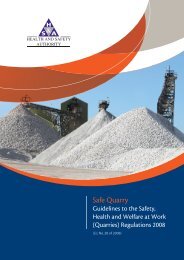Control of Major Accident Hazards Involving Dangerous Substances
Control of Major Accident Hazards Involving Dangerous Substances
Control of Major Accident Hazards Involving Dangerous Substances
You also want an ePaper? Increase the reach of your titles
YUMPU automatically turns print PDFs into web optimized ePapers that Google loves.
7. For the purposes <strong>of</strong> this Directive, a liquid is any substance that is not defined as a<br />
gas and that is not in the solid state at a temperature <strong>of</strong> 20ْ C and at a standard<br />
pressure <strong>of</strong> 101.3 kPa.<br />
PART 1<br />
Named substances<br />
Where a substance or group <strong>of</strong> substances listed in Part 1 also falls within a category<br />
<strong>of</strong> Part 2, the qualifying quantities set out in Part 1 must be used.<br />
Column 1 Column 2 Column 3<br />
Qualifying quantity (tonnes)<br />
<strong>Dangerous</strong> substances<br />
for the application <strong>of</strong><br />
Articles 6 and Article 9<br />
7<br />
Ammonium nitrate (see note 1) 5000 10000<br />
Ammonium nitrate (see note 2) 1250 5000<br />
Ammonium nitrate (see note 3) 350 2500<br />
Ammonium nitrate (see note 4) 10 50<br />
Potassium nitrate (see note 5) 5000 10000<br />
Potassium nitrate (see note 6) 1250 5000<br />
Arsenic pentoxide, arsenic (V) acid and/or<br />
salts<br />
1 2<br />
Arsenic trioxide, arsenious (III) acid and/or<br />
salts<br />
0.1<br />
Bromine 20 100<br />
Chlorine 10 25<br />
72
















